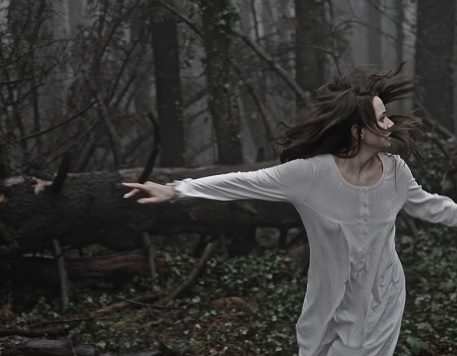Riccardo Paoletti is no stranger to the magic of Fellini. Once upon a time in 2006, the director presented a story of black and white, “Dailies” (In coda ai titoli), about crewmembers who worked at the legendary Cinecittà in the sixties. Paoletti’s latest project, Neverlake, captures a touch of Fellini’s magical realism and blends it with the horror of Dario Argento.
Jenny Brook (Daisy Keeping) is a 16-year-old American who travels to beautiful Tuscany to visit with her loving, but mysterious, father. Upon arrival, Jenny is enchanted by the Tuscan surroundings and reads plenty of Shelley while exploring the property. Dr. Brook, played by the veteran David Brandon, explains the significance of his Etruscan artifacts (out in plain view to be knocked over) while his stern lover Olga gives the impression that all may not be right in Neverlake land. It’s only a matter of time until young Jenny discovers the truth about the past and the frightening realities of the present.
The primary Italian influences of Neverlake are twofold. The setting is the historic “Lake of the Idols,” which was beheld by ancient Etruscans as a place of healing and mysticism. It was believed that one could escape sickness by tossing objects into the center of the waters, and for thousands of years, artifacts have been discovered at the lake. The Tuscan region of Italy was also significant in the life of romantic poet Mary Shelley as she lived in Pisa with her husband and fellow poet, Percy Bysshe Shelley, after the death of their first two children. The distressed Percy, who witnessed the mental deterioration of his wife, composed the Sensitive Plant, which is featured prominently in Neverlake. Two years after agonizing over the loss of his children, Percy Bysshe Shelley’s body would wash up on the shore near Viareggio, Italy and Mary was left with new stories to tell.
As one who has spent several months exploring Italy, I am especially fascinated with the historical background of Neverlake. Riccardo Paoletti’s film brought back memories of my own visit to the shores of Viareggio in 2012, and although the story of Shelley and “Lake of the Idols” was unknown to me during my visit, the unknown Tuscany is what Paoletti sought to express with his film.
Shelley’s Tuscany.
For love, and beauty, and delight,
There is no death nor change: their might
Exceeds our organs, which endure
No light, being themselves obscure-The Sensitive Plant
Riccardo Paoletti has made an ambitious film with Neverlake, however there is one gaping hole in his script and it takes the film down slowly like so many Etruscan artifacts sinking to the bottom of “The Lake of the Idols.” The “Twilight” influence. Yes, we are talking about a blatant reference to the dreamy Edward Cullen. Why, Riccardo, why?
The opening visuals of Neverlake are beautiful along with the narration of Shelley’s text, and one can’t help but be enchanted by the beauty of Daisy Keeping and her lovely voice. Dr. Brook and Olga provide all brooding and creepy dialogue that is needed for the film to work, but director Paoletti just had to include a Robert Pattinson lookalike with pale skin. The “Twilighty” character, Peter (Martin Kashirokov), is initially hidden from view and utters these horrific lines once he slowly takes off his blue hoodie.
Daisy: Do you like love stories?
Peter: Yes . . . but only the ones with tragic endings.
The dialogue is not necessarily the problem, it’s that Peter could be Edward Cullen’s long-lost brother. Unfortunately, Peter’s lines don’t get much better:
Peter: Are you scared of me?
Daisy: Should I be?
Peter: Maybe I’m evil.
Aside from the troubling Peter character, Riccardo Paoletti has made a unique and inventive film. The cast holds the story above water with superb performances led by the watchable and incredibly likable Daisy Keeping. It’s not difficult to imagine Neverlake as a successful television series, however the plot twists, surprising as they may be, are not enough to keep one interested about the intriguing backstories and keep the film afloat as a stand-alone.
The filmmaking itself is on point with the magnificent cinematography of Cesare Danese, as is the sharp editing by Francesco Galli and Paoletti’s ability to capture the claustrophobic feeling of the interiors and also the murky setting of Neverlake. It was interesting to witness the lead character quote Shelley amongst Etruscan artifacts and resort to her iPad for light in the darkness. The tight close-ups are quite memorable along with the visuals of opening (and shutting) doors. Paoletti’s filmmaking abilities are extraordinary, and his career will be enjoyable to follow, but unfortunately the plot of Neverlake has a slight tinge of predictability and the Peter character is a huge distraction. But then again — maybe it won’t be a distraction to millions of “Twilight” fanatics. Genius move?






'Movie Review: Neverlake (2013)' has no comments